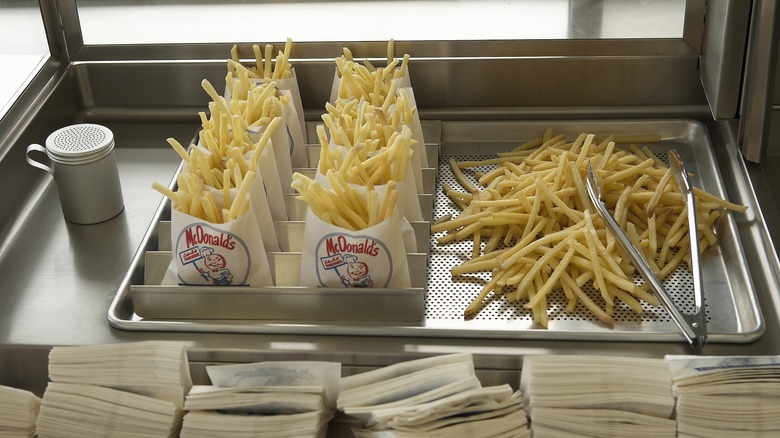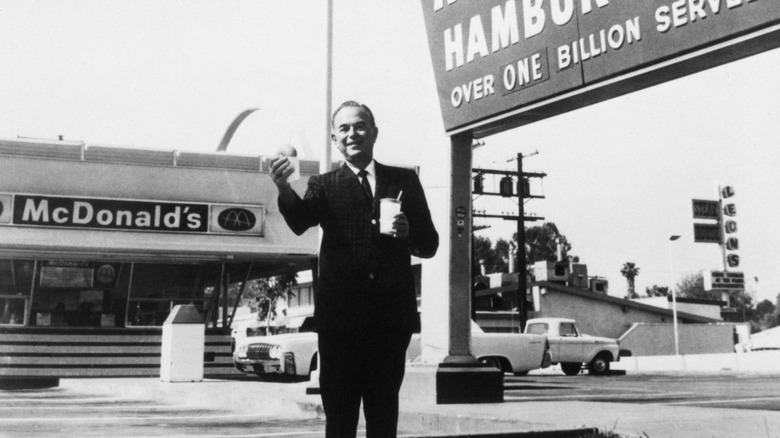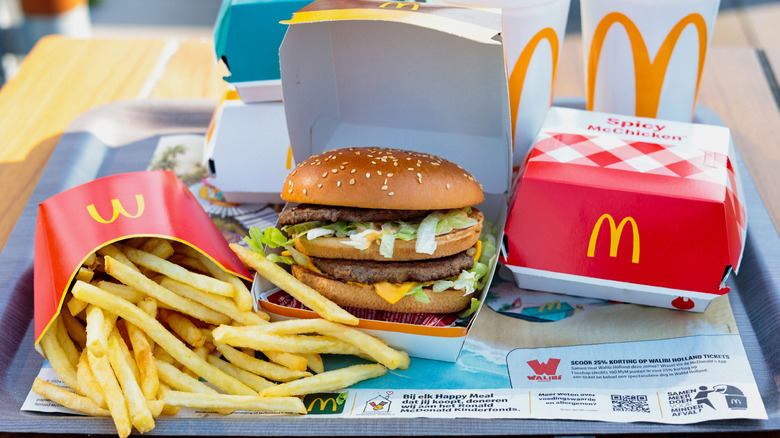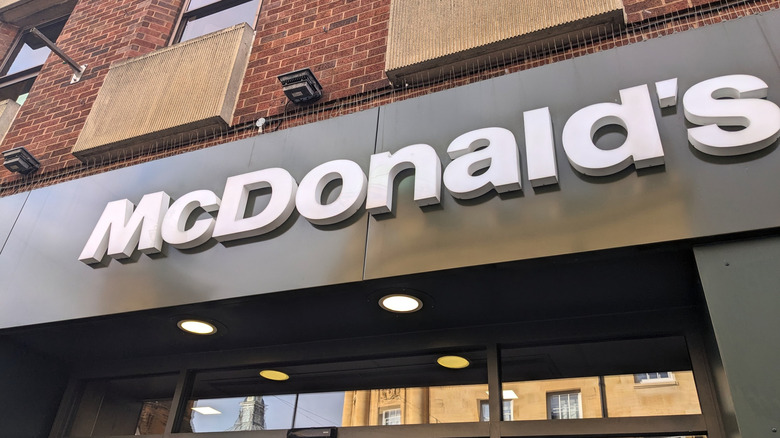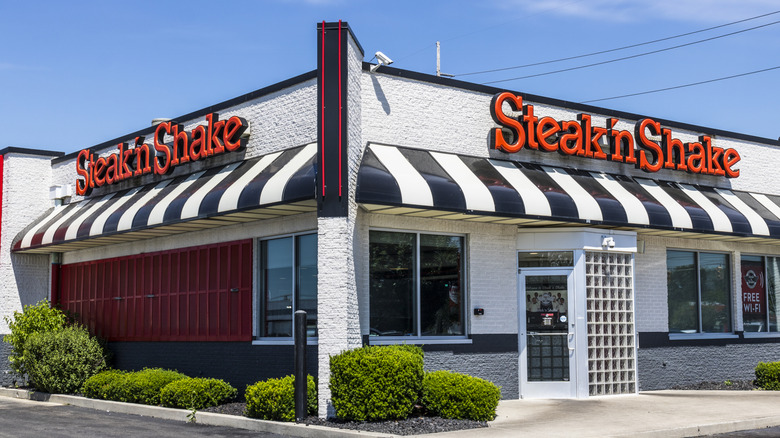The Greasy, Glorious History Of The McDonald's Fry
McDonald's french fries are widely considered the best in the business, yet their popularity obscures an inconvenient truth. For many, today's version is a disappointing echo of a far superior original (though the burgers seem to be stepping it up). The legendary fry that debuted in the company's early years wasn't born from a corporate lab, but emerged from a shrewd cost-cutting decision.
The foundation for this icon was laid at the original McDonald's brothers' stand in San Bernardino, where the fries were the main attraction. The process was simple but sacred: carefully sourced Idaho russets were peeled, chopped, rinsed, soaked, drained, dried, and then fried in beef fat, salted and served piping hot. Their quality so captivated a traveling salesman that he devoted his career to chasing their perfection. For decades, this meticulously crafted, beefy standard was the undisputed king of fast food, creating an indelible memory of taste and texture for a generation.
This is the story of that perfect fry: How one franchise agent built an empire upon its golden allure, how a health crusader waged a multi-million-dollar war to destroy it, and how the well-intentioned switch to vegetable oil created an imposter that still fails to live up to its nostalgic predecessor. We're tracing the greasy, glorious history of the one that got away.
The original fry was created by accident
The classic McDonald's fry materialized from a supplier's cheap workaround. Unable to afford the expensive equipment needed for hydrogenated vegetable oil, Interstate Foods stretched its product with beef tallow. The resulting blend boasted 93% beef fat and 7% cottonseed oil, a cheap fix that yielded an unparalleled masterpiece: a fry with a shatteringly crisp exterior and a buttery interior that captivated the world. This oil blend came to be known as Formula 47.
Yet this secret ingredient was hardly new. Beef tallow is rendered beef fat, a foundational cooking oil with a history stretching back centuries, prized for its high smoke point and savory flavor. Beyond giving fast food fries their signature richness, this remarkably versatile fat was used for everything from flaky pie crusts and hearty stews to making candles and soap. Long before nutritionists debated its saturated fat content, beef tallow was the default for frying in America, the essence of greasy spoon diners that predated the golden arches.
Hardly innovative, McDonald's was simply using what worked. This pivot to a classic, shelf-stable tallow blend was the happy accident that set an impossible standard, a delicious benchmark the chain has been trying to recapture ever since.
One man discovered and franchised it
In 1954, five years after french fries permanently replaced potato chips on the menu, the McDonald's brothers' creation found an unlikely champion in Ray Kroc. The beefy golden fry so captivated this hustling Multimixer salesman that he immediately bought the franchise rights to McDonald's, initially convinced the concept would peak at just 1,000 restaurants across America. But his vision required more than ambition; it demanded technological innovation to achieve consistency across thousands of locations.
Kroc assembled a dream team to perfect the system. He partnered with J.R. Simplot, an Idaho entrepreneur who had pioneered frozen food technology during World War II. Simplot's breakthrough in freezing french fries, using a process of blanching and compressing, made nationwide distribution possible. Meanwhile, former Kraft food scientist (and Cheez Whiz co-creator) Edwin Traisman, was tasked by Kroc to solve consistency issues, and developed the crucial method for controlling potato moisture before freezing. These innovations, combined with Kroc's own "potato computer" to determine the ideal cooking time, transformed a single-stand recipe into a globally consistent icon.
The fry became a world-famous staple
The signature fry — with its crispy edges, silky interior, and precise length — transcended its humble origins to become beloved across the globe. It captivated the palates of industry legends, from James Beard and Julia Child to French master Paul Bocuse.
This universal appeal, bridging the gap between haute cuisine and everyday comfort food, directly fueled McDonald's explosive worldwide expansion. Its success proved that a perfectly engineered fry could conquer even the most discerning markets like Paris. That Bocuse would later try to capture that same magic in his own fast-food venture is perhaps the highest compliment a fry could ever receive.
Even today, the pursuit of that original, true beefy potato snack borders on obsession. From food scientists to YouTube investigators, everyone's still chasing the magic of the original formula, trying to bring back the fry that changed fast food forever. Yet the core ingredient that elevated the status of this fry in those early years would soon render it public enemy No. 1.
A health crusader campaigned against it
Enter Phil Sokolof, a Nebraska businessman who, after a near-fatal heart attack, declared war on the tallow that gave the fry its soul. He sold his manufacturing company and poured millions of his personal fortune into the National Heart Savers Association, launching a relentless crusade against cholesterol. His weapon of choice: the full-page newspaper ad.
Sokolof was an unlikely poster boy for the cause. A former big band singer who became a self-made millionaire in drywall manufacturing, his 1966 heart attack at age 43 was a profound shock. He was thin, athletic, and a non-smoker, but confessed to a lifelong love of greasy food that had driven his cholesterol to 300. After recovering, he became a self-taught expert, conducting mass public cholesterol screenings before taking his fight to the pages of America's print media.
With blunt, alarming headlines like "McDonald's, Your Hamburgers Have Too Much Fat!" and "We Can't Continue to Deep-Fry Our Children's Health," he placed the fast-food giant squarely in the crosshairs of the growing health conversation. His campaign was so effective that Bryant Gumbel once introduced him on "The Today Show" as "America's No. 1 Cholesterol Fighter." The public pressure became immense.
McDonald's eventually replaced the tallow
In the summer of 1990, the golden age of the McDonald's fry officially ended. Bowing to relentless heat from Phil Sokolof's amplified health crusade, the fast food giant announced it would abandon its signature beef tallow blend for 100% vegetable oil. While the company publicly credited "ongoing research," the timing was no coincidence: This was a direct concession to health advocates. The immediate consequence was a stark diminishment of a distinctive flavor that had defined the fry for decades.
The move backfired spectacularly. Not only did the new fry fail to deliver the same gustatory experience, but McDonald's stock price fell 8.3% following the announcement. The company had traded its culinary soul for perceived health credentials, swapping a legendary recipe for a pale imitation. It was a decision that satisfied the nutritionists but broke the hearts of a generation of customers, creating a vacuum of flavor that the chain has been trying to fill ever since.
The new vegetable oil fry was inferior
McDonald's recipe swap solved a public relations crisis but created a culinary disaster. The new fries, cooked in hydrogenated vegetable oil, were lackluster, a shadow of their former crispy golden selves. The addition of beef flavoring failed to replicate the savory depth that beef tallow had once naturally provided. Julia Child captured the universal disappointment in 1995, declaring on television that the fries had become "kind of limp ever since."
It's no surprise that the health-conscious reformulation proved equally problematic. The switch to hydrogenated vegetable oil introduced harmful trans fats, creating different health concerns than those posed by saturated fat. Even today, the term "vegetable oil" remains a catch-all for any oil extracted from plant sources like seeds, nuts, grains, or fruits, offering little clarity on its specific composition.
Meanwhile, the beef flavoring — derived from animal products and milk byproducts — sparked a 2001 lawsuit from religious and vegetarian groups who felt deceived. This error ultimately cost McDonald's $10 million in settlements, despite the argument that the company never claimed the fries were vegetarian. In trying to please everyone, the chain had created a fry that was neither genuinely healthy nor remotely as good as the original, not to mention fit for certain diets.
The recipe changed again in the 2000s
The new millennium brought no respite for McDonald's fry engineers. Mounting evidence against trans fats forced the chain into a defensive decade of oil reformulation. In 2002, McDonald's announced a partnership with agri-giant Cargill to develop a "trans fat-reduced" oil, presenting it as consumer choice rather than necessity. But this was merely an opening act. The real pressure arrived with New York City's landmark 2007 ban on artificial trans fats in restaurants — a regulatory measure that forced McDonald's hand. After years of secretive testing, the company finally confirmed it had found "the right oil," beginning a cautious rollout that saw the new trans-fat-free blend slowly appear in select locations and then across its entire empire.
This endless quest for a politically acceptable fry resulted in a complex ingredient list. The current American version relies on a cocktail of nearly 20 components, including dextrose for browning, sodium acid pyrophosphate to prevent graying, and polydimethylsiloxane to reduce foaming in the fryer. The beef flavor that appears on the list offers a final irony: it contains no actual beef, but is instead created from wheat and milk derivatives. This stands in stark contrast to the simpler recipes used in overseas franchises, such as in Germany, where fries are made with just potatoes, sunflower oil, and a few basic ingredients. The journey from the straightforward beef tallow fry to today's scientifically engineered version highlights a decades-long struggle to balance public health concerns with the elusive goal of recapturing a time-tested technique.
Many fans still want the original recipe back
A growing coalition of chefs, nutritionists, and fast-food fans is demanding what once seemed unthinkable: a return to McDonald's original beef tallow fry. This isn't only nostalgia talking: Proponents argue that modern science has vindicated the very ingredient they were once pressured to abandon. They contend that beef tallow, being a stable, saturated fat, is actually a healthier alternative to the inflammatory seed oils used today, pointing to studies linking seed oil consumption to chronic diseases while highlighting tallow's beneficial compounds like conjugated linoleic acid.
This movement is gaining mainstream traction. Competitors like Steak 'n Shake have already committed to switching to 100% beef tallow. A Change.org petition echoes this sentiment, urging McDonald's to return to the classic recipe as a step toward both better health and superior taste. For a generation that remembers the fry's former glory, the current version remains a placeholder — a constant reminder that the chain's greatest mistake was ever letting the original recipe go.
Other companies have heard the call
In addition to Steak 'n Shake, a growing number of chains have embraced beef tallow in response to consumer demand. Popeyes continues to use a beef tallow and vegetable oil blend to achieve superior crispness in its proprietary chicken recipe. Chicago's Portillo's employs a beef tallow blend for its crinkle-cut fries and onion rings, while Smashburger cooks its signature fries and tots in a beef tallow-canola oil mixture. Buffalo Wild Wings even uses pure beef shortening across its entire fried menu, from chicken wings to cheese curds.
These chains recognize what culinary traditions have long suggested: Beef tallow creates an unparalleled texture and flavor profile that seed oils simply cannot match. Yet despite this industry shift and persistent customer petitions, McDonald's — the OG of the fast food tallow-fried fry — remains on the sidelines. The current version of the fries still commands remarkable loyalty, regularly topping bestseller lists and Reddit debates. This enduring popularity makes one wonder: If the latest version inspires such devotion, what might happen if the brand finally brought back the real thing?


